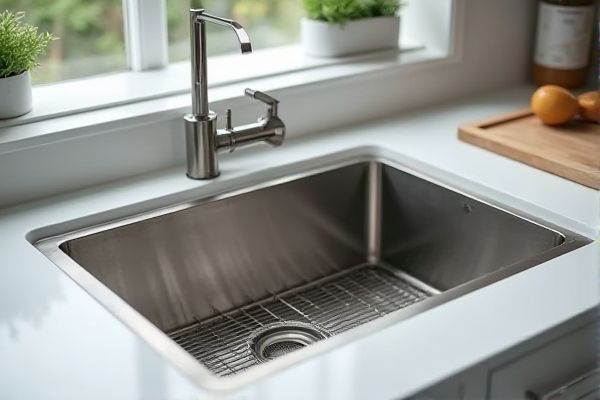
A colander sink integrates a built-in strainer, allowing you to easily rinse fruits, vegetables, and pasta without extra tools, while a plain sink offers a simple basin for versatile use and cleaning. Explore the rest of the article to discover which sink type perfectly suits your kitchen needs and lifestyle.
Table of Comparison
| Feature | Colander Sink | Plain Sink |
|---|---|---|
| Purpose | Integrated straining and washing | Basic washing and rinsing |
| Design | Includes built-in colander or draining section | Simple bowl without drainage features |
| Functionality | Allows easy rinsing and draining of foods | Standard washing without draining integration |
| Convenience | Reduces need for separate colander | Requires additional colander for draining |
| Cleaning | May require extra care for colander parts | Easy to clean due to simple design |
| Cost | Typically higher due to added features | Usually more affordable and basic |
| Material | Stainless steel, durable composite | Stainless steel, porcelain, or composite |
Introduction to Colander Sink vs Plain Sink
Colander sinks feature built-in draining baskets that facilitate efficient washing and draining of vegetables and pasta directly in the sink, reducing countertop clutter. Plain sinks offer a versatile basin ideal for general cleaning tasks but lack integrated accessories for specific kitchen prep functions. Choosing between colander and plain sinks depends on workflow preferences, with colander sinks enhancing convenience during food preparation.
Key Features of Colander Sinks
Colander sinks feature built-in perforated basins that facilitate efficient rinsing and draining of fruits, vegetables, and pasta directly over the sink, enhancing kitchen workflow. Constructed from durable materials like stainless steel or granite composite, these sinks often incorporate removable or integrated strainers to prevent food debris from clogging drains. Their multifunctional design combines washing and draining tasks, making them a practical choice for busy kitchens seeking both convenience and hygiene.
Advantages of Using a Colander Sink
A colander sink offers enhanced kitchen efficiency by combining a traditional sink with a built-in strainer, allowing seamless washing and draining of fruits, vegetables, and pasta. Its design reduces countertop clutter and minimizes the need for additional strainers, improving workflow during meal preparation. This innovative feature also promotes better water drainage and reduces the risk of clogging compared to plain sinks.
Benefits of Choosing a Plain Sink
Plain sinks offer a sleek, minimalist design that seamlessly integrates into modern kitchens, providing ample space for washing large pots and pans without obstructions. Their smooth surfaces are easier to clean and maintain, reducing the risk of food particles getting trapped as can happen in colander sinks. Choosing a plain sink enhances your kitchen's versatility and hygiene, making everyday tasks more efficient.
Design and Aesthetic Differences
Colander sinks feature built-in perforated bottoms or removable inserts designed for efficient washing and draining, combining functionality with modern, industrial aesthetics. Plain sinks offer a smooth, uninterrupted basin surface that provides a timeless and minimalist look, easily blending with various kitchen styles. Your choice depends on whether you prioritize a specialized design element or a versatile, classic appearance in your kitchen.
Functionality and Everyday Use
A colander sink combines the functionality of a traditional sink with built-in straining, allowing you to rinse vegetables and drain pasta directly without extra dishes, which streamlines food prep and cleanup. Plain sinks offer versatile, open space ideal for washing larger items or filling pots but require separate strainers for draining tasks, potentially increasing countertop clutter. Choosing a colander sink enhances convenience and efficiency for everyday cooking, especially in busy kitchens where multitasking is essential.
Maintenance and Cleaning Requirements
Colander sinks simplify maintenance by allowing food particles to be easily rinsed away through built-in perforations, reducing residue buildup and minimizing the risk of clogs. Plain sinks require more frequent use of strainers and manual cleaning to prevent blockage and maintain hygiene. Your kitchen efficiency improves with a colander sink, as it cuts down cleaning time and helps keep surfaces cleaner.
Installation and Space Considerations
Colander sinks feature built-in strainers or perforated sections that require additional plumbing adjustments, making installation slightly more complex than plain sinks, which typically involve standard fitting procedures. Space considerations for colander sinks include accommodating extra drainage components, potentially reducing usable basin area, whereas plain sinks offer a straightforward, unobstructed basin ideal for maximizing sink volume. Choosing a colander sink can improve kitchen efficiency if your workspace can handle the installation nuances and limited basin space it entails.
Cost Comparison: Colander Sink vs Plain Sink
Colander sinks typically cost between $300 and $600, influenced by materials like stainless steel or composite, while plain sinks range from $200 to $500, making them generally more affordable. Installation expenses also vary, with colander sinks requiring slightly higher labor costs due to added features and plumbing complexity. Your choice impacts budget considerations, as colander sinks combine functionality with a higher upfront investment compared to plain sinks.
Which Sink is Best for Your Kitchen?
A colander sink offers integrated drainage with perforated basins that simplify washing and draining vegetables or pasta directly in the sink, reducing countertop clutter and improving kitchen efficiency. Plain sinks provide a smooth, uninterrupted basin ideal for soaking dishes, washing large pots, and versatile cleaning tasks without risk of food particles clogging drain holes. Choosing the best sink depends on your cooking habits and kitchen workflow, where a colander sink suits those prioritizing multitasking and convenience, while a plain sink caters to users needing a spacious, unobstructed basin.
 homyna.com
homyna.com